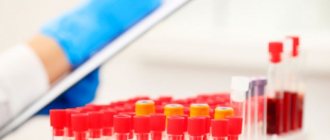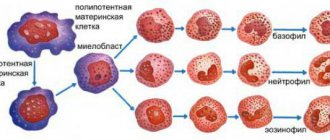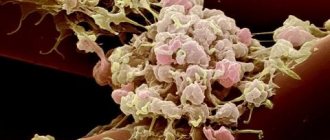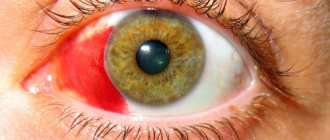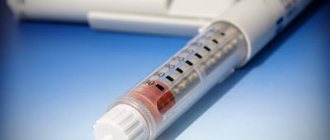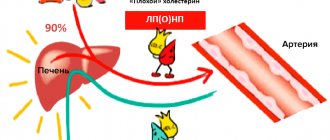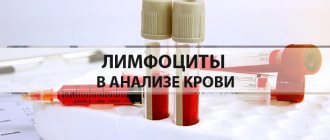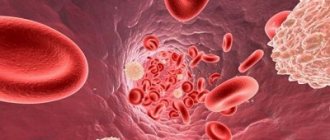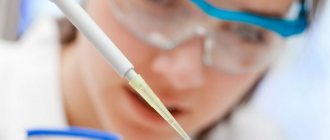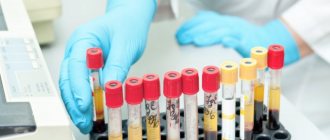Author: Sozinova A.V., obstetrician-gynecologist, has been in continuous practice since 2001. January, 2021.
Synonyms: platelets, platelet count, PC, plt.
Platelets are blood cells, and their concentration is determined during a general blood test. On the CBC form, platelets are designated as platelet count or PC. Blood for studying its composition, including counting the number of platelets, is taken from a finger (capillary) or from a vein. The unit of measurement for platelets is the number (N) of cells multiplied by 109 per liter.
Platelets, like other formed elements, are formed in the red bone marrow. Their lifespan in the bloodstream is about 7–12 days. Destruction and breakdown of cells occurs in the spleen and liver tissues.
The main function of platelets is to carry out hemostasis, that is, to stop bleeding. Contact with damaged tissues causes transformation of cells, up to 10 processes are formed in them, and when they spread, the wound is closed with a platelet mass (thrombus). Thus, platelets prevent large amounts of blood from leaking out of damaged soft tissues.
Another equally important function of platelets is to protect the injured area from the penetration of pathogenic microorganisms (they secrete lysozyme and B-lysine).
Platelets also participate in the processes of hemostasis (maintaining the internal environment of the body), nutrition of the capillary endothelium (the inner layer of the walls of blood vessels) and regenerative processes of damaged tissues due to the release of growth factors that stimulate cell division.
A 2021 scientific paper provides evidence showing that in addition to the above functions, platelets also play an important role in the human immune system.
Indications
Prescription of an OAC with a study of platelet concentration is indicated for all patients who visit the clinic, undergo a routine medical examination, or receive a referral for inpatient treatment. Also, platelet determination is prescribed to all patients requiring surgery (emergency or planned). The main indications for platelet testing include:
- suspicion of disturbances in the hemostatic system (bleeding, formation of subcutaneous hematomas);
- suspicion of a malignant process;
- immunity disorders;
- bronchopulmonary pathology;
- diseases of the digestive tract and urinary system (stomach ulcer, glomerulonephritis);
- cardiovascular pathology;
- endocrine disorders (obesity, diabetes).
Symptoms that should alert you
- red, purple bruises on the skin
- frequent nosebleeds, bleeding gums
- prolonged bleeding of even small wounds or cuts
- heavy menstrual bleeding in women
How can you help?
The danger of thrombocytosis is that when platelets are elevated, they collide with each other. The result is activation of blood clotting processes. This cannot be safe, especially for people at risk for vascular diseases (heart attack, thrombosis of the arteries of the extremities and internal organs, stroke, progression of the consequences of atherosclerosis, venous pathology in the form of thrombophlebitis and phlebothrombosis).
This will really help resolve the situation:
- Thorough diagnosis of all possible causes of thrombocytosis: detailed clinical and biochemical blood test, chest x-ray, ultrasound examination of internal organs, etc.;
- Treatment of the underlying cause that caused the situation in which platelets become elevated;
- Taking blood thinning drugs: aspirin, cardiomagnyl, lospirin, trental;
- In severe cases of thrombocytosis, heparin and warfarin are prescribed. For primary thrombocytosis, therapeutic bloodletting is indicated.
High platelets are not a common condition. But it requires timely correct assessment and specific therapeutic measures. Therefore, if thrombocytosis is detected in blood tests, its assessment and correction should be entrusted exclusively to the hands of a qualified specialist.
Preparing for the study
Before taking the OAC, you should stop drinking alcoholic beverages, fatty, spicy, excessively salty and fried foods the day before the procedure. Blood is donated on an empty stomach, the patient is advised to maintain physical and emotional peace (refrain from sudden movements, climbing stairs, avoid stressful situations) for half an hour before the test. Also, platelet testing is not recommended immediately after recovery from a long-term illness, which may distort the results due to weakened immunity.
Detailed instructions for preparing for a general blood test are here.
Prevention
There is no specific prophylaxis for thrombocytopenia. It is recommended to lead a healthy lifestyle, including proper nutrition, normal sleep, not to overload yourself with work, abstain from drinking alcohol and tobacco products, treat infectious diseases in a timely manner and carry out routine vaccinations. Consult a doctor promptly if there is a sudden disturbance in the body’s functioning.
Author: infectious disease doctor. Allergist-immunologist Natalia Nikolaevna Gordienko
Platelet norms
Important! Standards may vary depending on the reagents and equipment used in each particular laboratory. That is why, when interpreting the results, it is necessary to use the standards adopted in the laboratory where the analysis was carried out. You also need to pay attention to the units of measurement.
The list shows the reference values of platelet cells adopted in the Invitro laboratory:
| Age | Platelet concentration, thousand/µl (103 cells/µl) | |
| Children | boys | girls |
| less than 2 weeks | 218 — 419 | 144 — 449 |
| 2 weeks — 1 month | 248 — 586 | 279 — 571 |
| 1 - 2 months | 229 — 562 | 331 — 597 |
| 2 — 6 | 244 — 529 | 247 — 580 |
| 6 months - 2 years | 206 — 445 | 214 — 459 |
| 2 years - 6 years | 202 — 403 | 189 — 394 |
| Adults | men and women | |
| over 6 years old | 150 — 400 | |
In the Helix laboratory there is a slightly different gradation of values:
| Age | Reference values 109/l |
| Less than 10 days | 99 — 421 |
| 10 days – 1 month | 150 — 400 |
| 1-6 months | 180 — 400 |
| 6 months – 1 year | 160 — 390 |
| 1-5 years | 150 — 400 |
| 5-10 years | 180 — 450 |
| 10-15 years | 150 — 450 |
| More than 15 years | 150 — 400 |
It should be noted that the platelet count decreases slightly in women during the menstrual period, but returns to normal after bleeding stops. A slight decrease (up to 150) in platelet concentration during the gestational period is also possible, which is explained by blood dilution due to an increase in BCC (circulating blood volume) and due to insufficient nutrition of the expectant mother.
Important! The interpretation of the results is always carried out comprehensively. It is impossible to make an accurate diagnosis based on only one analysis.
Causes
It is difficult to determine what influenced the increase in platelets in the blood. To determine the causes in a woman or man, the doctor needs to evaluate the results of a comprehensive examination of the body. He will also need to assess your current condition and the presence of chronic diseases that may cause your platelets to be elevated.
Type of blood clot
An increase in the level of these elements in the blood can be provoked by:
- Diseases of the circulatory system;
- Exacerbations of chronic ailments;
- Inflammatory processes in the body;
- The presence of a virus infection in the blood;
- Consequences of surgical interventions;
- Taking certain medications;
- The influence of colds and flu.
Drugs that affect platelet levels
Long-term use of these drugs may change platelet levels:
- aspirin
- pain relievers such as ibuprofen and naproxen
- antihistamines
- asthma medicine
- sildenafil (Viagra)
- drugs used to prevent blood clots, such as clopidogrel
- antibiotics
- antidepressants and antipsychotic drugs
- Cholesterol-lowering drugs (statins)
- calcium channel blockers (verapamil).
Platelets are reduced (thrombocytopenia)
When the concentration of platelets in the CBC decreases, they speak of the development of thrombocytopenia, which is accompanied by a blood clotting disorder and a tendency to bleed (gums bleed, nosebleeds or intestinal bleeding often occur, menstruation becomes long and heavy). Thrombocytopenia develops in a number of serious diseases due to the loss of elasticity of the vascular wall, their fragility and fragility and the risk of internal bleeding.
Reasons that provoke a decrease in platelet levels include:
- hemolytic-uremic syndrome or Gasser's disease (a combination of hemolytic anemia, thrombocytopenia and acute kidney failure);
- thrombocytopenic purpura or Werlhof's disease (one of the widows of hemorrhagic diathesis);
- allergic thrombocytopenia (taking a number of medications: procainamide, heparin, co-trimoxazole);
- DIC syndrome (second stage);
- severe liver damage (hepatitis, cirrhosis);
- alcoholism;
- malaria;
- enlarged spleen;
- bone marrow diseases, some leukemias;
- megaloblastic anemia;
- pathology of the thyroid gland (hypothyroidism, thyrotoxicosis).
It is important to note that a decrease in platelet concentration (75 – 150) is observed in pregnant women, which is not regarded as a pathology.
General information
Platelets are granulocytic blood cells without a biconvex nucleus, formed from plasma cells of the bone marrow. They are presented in different forms - young, adult and mature. The diameter is directly proportional to age: 2-4 microns. Platelets contain granules that create blood clotting proteins, lytic enzymes, phosphatase and cathepsin, create serotonin, calcium ions and ATP, and contain lysosomal enzymes.
One of the most important functions of blood platelets is participation in blood clotting (primary hemostasis).
Platelets bind clotting factors, making blood clots thicker. As a rule, in an inactive state, when the vessel wall is damaged, platelets are directed to the damaged area. Thanks to the pseudopods located on the surface of the body, they are attached to each other and the vascular wall, forming a blood clot, which is an excellent barrier to bleeding. In the active state, platelets are able to change the shape of the body, due to which they increase their area, and this allows them to completely close the damage.
In addition, platelets are able to protect the body from foreign bodies by catching them with the help of pseudopods, and then digesting them with the help of the enzyme lysocine, which is formed from platelet factors (thrombin, thromboxane), from platelet granules. Thus, platelets are important for the immune response, being “killer” cells for foreign agents entering the body.
Blood plates serve as a storage site for serotonin, providing antitumor and radioprotective effects.
Thus, a violation of the number of platelets leads to inhibition of their functions, this certainly leads to disruption of the body’s activity and entails negative symptoms.
Platelets are increased (thrombocytosis)
An increase in platelet count (thrombocytosis) is observed when:
- excessive physical stress
- chronic inflammatory processes (rheumatoid arthritis, tuberculosis, sarcoidosis);
- myeloproliferative diseases (primary erythrosis, chronic myeloid leukemia, myelofibrosis, myelosclerosis);
- some hemolytic anemias;
- hemolysis or severe blood loss;
- carcinoma, lymphoma;
- after removal of the spleen.
Sources:
- Eugenio D. Hottz. Platelets in Immune Response to Virus and Immunopathology of Viral Infections. — Front Med (Lausanne). Apr 2018.
- Data from the independent laboratory Invitro.
- Data from Helix laboratory.
- Steven Kim, MD. Acquired Platelet Function Disorder. — Healthline, Jan 2021
- Douglas B. Cines. Thrombocytopenia in pregnancy. - Blood. 2017 Nov 23; 130(21): 2271–2277
- Danilova L.A., Doctor of Medical Sciences, Prof. Analyzes of human blood, urine and other biological fluids at different age periods, SpetsLit, 2014.
How to lower platelets in the blood in women and men?
An increased level of platelets in the blood of women is corrected by the attending physician after a complete diagnosis. The prognosis of the outcome directly depends on the literacy and timeliness of the selected correction methods. During the course of therapy, emotional and physical stress is contraindicated for the patient.
When treating the primary form of high platelet count, it is important to take into account the age of the patient and the presence of associated complications. Treatment methods for reactive thrombocytosis directly depend on the root cause that caused this deviation.
How to reduce platelets in the blood with diet?
Diet for thrombocytosis is of particular importance for successful recovery. The patient will have to remove spicy and fatty foods, alcohol, as well as any types of sauces and ketchups from his diet. You will also have to give up bananas, nuts, mangoes, pomegranates and rosehips, since these foods increase the number of platelets.
Products that reduce platelets in the blood include:
- green apples;
- garlic;
- seafood;
- almond;
- buckwheat;
- fresh herbs;
- lingonberries; grape.
Fish oil and Omega-3® may also be prescribed.
By decision of the doctor, medications that promote the growth of the cells in question are discontinued. Particular attention should be paid to antidepressants and antibacterial drugs.
It is useful to take complexes of vitamins A, B12 and C. However, before taking them, it is advisable to determine the level of vitamins in the blood using a laboratory test. Since not only a deficiency, but also an excess of the substances in question negatively affects the process of hematopoiesis in the human body.
It is important to maintain the correct drinking regime. For an adult, the minimum amount of water per day should not be less than two liters. The result of drinking less water is a narrowing of blood vessels and thickening of the blood. Subsequently, this condition can cause false thrombocytosis.
How to reduce platelets in the blood with the help of drugs?
The question of the need to prescribe drugs, determining the required dosage and duration of administration is decided exclusively by the attending physician. Medicines are selected that thin the blood and also prevent platelet aggregation and the formation of blood clots.
The most popular medicine is aspirin®. Taking aspirin should be agreed with the attending physician and is carried out under the control of laboratory blood parameters.
Important: if surgical intervention is necessary, the patient must notify the attending physician about taking aspirin. Since the operation is accompanied by the risk of bleeding, which can become fatal if blood clotting slows down.
It should be noted that while taking aspirin, a person is less likely to remove uric acid from tissues. This can lead to the development of gout. The combined use of alcohol and aspirin is strictly contraindicated due to the high risk of bleeding of the digestive organs.
The administration of hydroxyurea is advisable for malignant neoplasms. The mechanism of action of the drug is based on the suppression of an enzyme necessary for the synthesis of DNA in mutant cancer cells after exposure to radiation or chemotherapy. Combined use with other methods of therapy significantly increases the inhibitory effect on the work of the bone marrow to produce blood cells.
The drug Bisulfan® has a similar effect. However, the mechanism of its destructive effect on tumor cells is the formation of cross-links between DNA strands. This leads to the impossibility of full functioning of the nucleic acid and cell death.
Anagrelide® is a drug that effectively reduces the number of platelets. However, the mechanism of its effect still remains questionable. The effectiveness and safety of anagrelide® has been proven in clinical and laboratory tests. It is assumed that the drug directly affects megakaryocytes, preventing their further differentiation into platelets. Megakaryocytes decrease in size and produce fewer blood cells.
